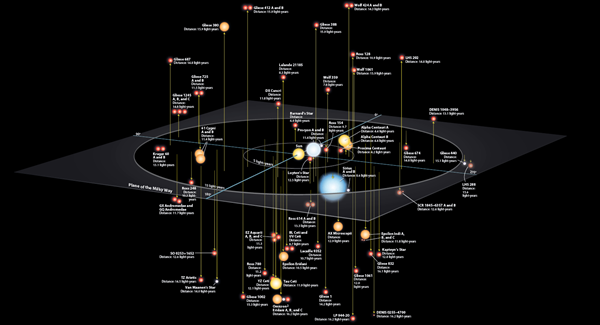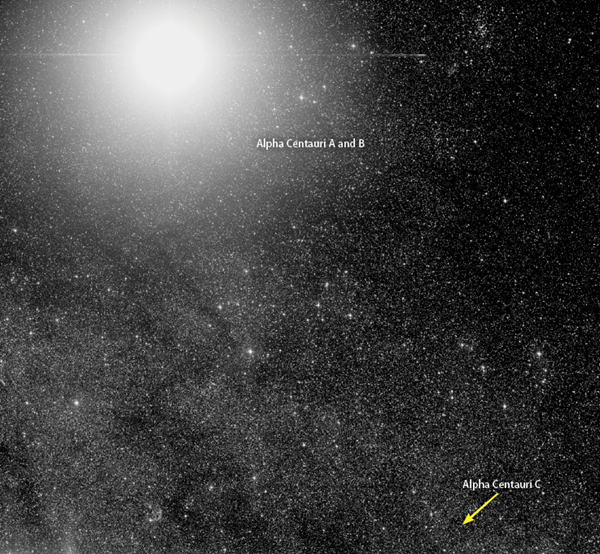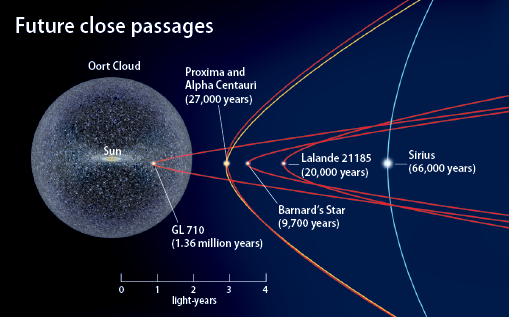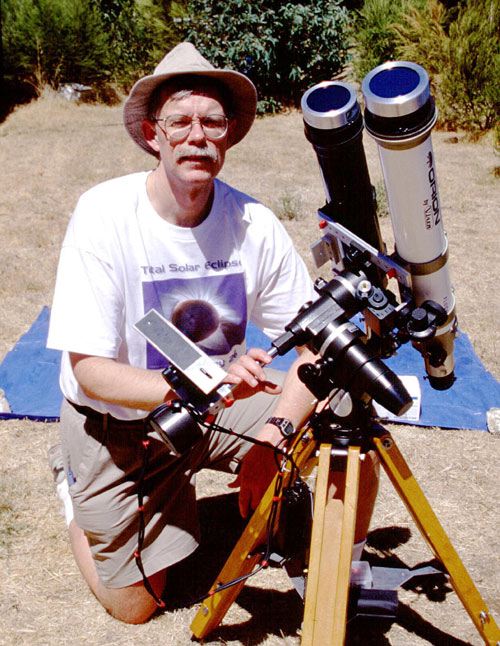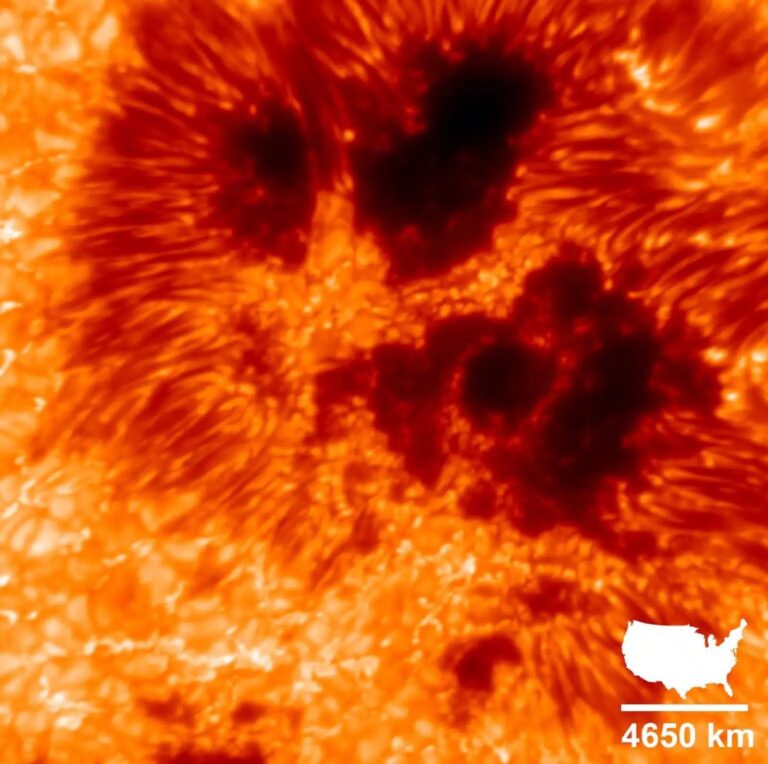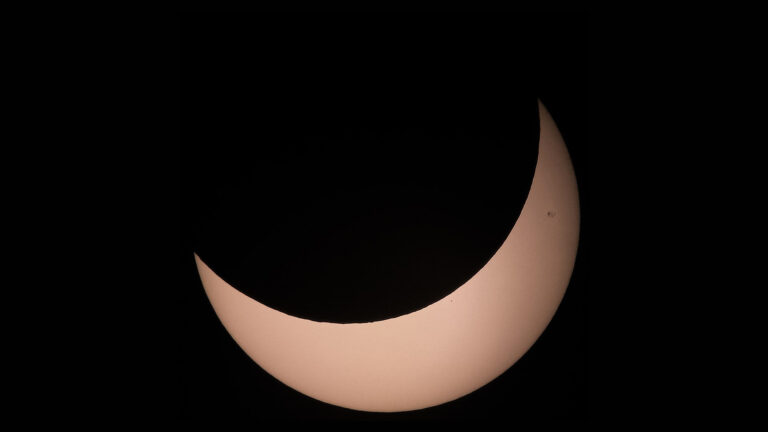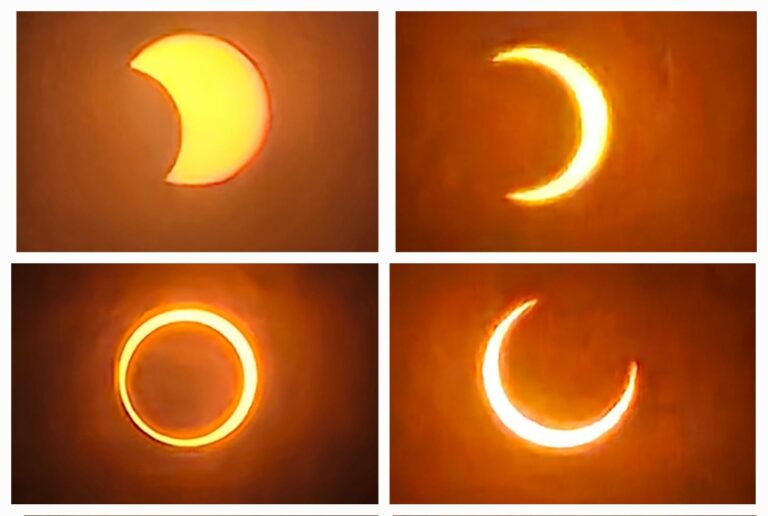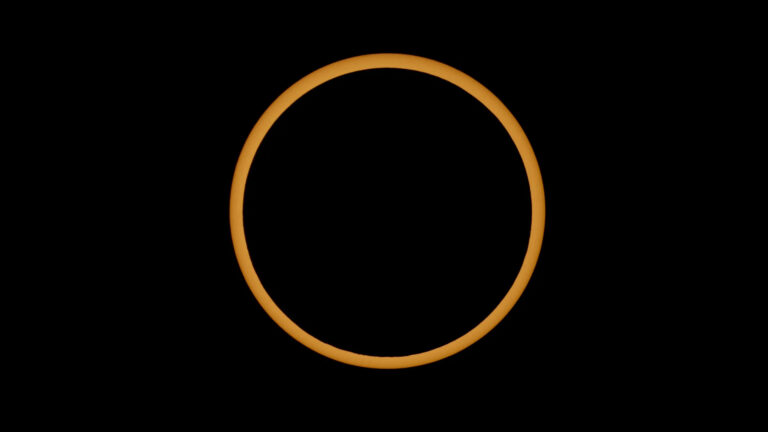Key Takeaways:
- Our sun's neighborhood contains 71 stars within 30 light-years.
- Most nearby stars are cool, red dwarf stars.
- Many nearby stars have planets orbiting them.
- “We can’t help but wonder if the Sun’s nearest stellar neighbors harbor hospitable planetary neighbors as well, some perhaps like Earth.” said Roen Kelly.
Two-thirds of our stellar neighbors are cool M-class dwarf stars. The remaining third is a mixture of white dwarfs; type K, G, F, and A main sequence stars; and a handful of T- and L-class brown dwarfs. The stars’ sizes are scaled relative to each other, not to the distances between them. All stellar data are from the Research Consortium on Nearby Stars (RECONS).
Most of the space in the Milky Way Galaxy can be pretty lonely — a dull, dark void. But our own neighborhood stands out as among the more intriguing places in the universe. Recently, with new telescopic technologies, astronomers have made big strides toward finding all our stellar neighbors. Knowing the stellar cast, they can then project this information into the galaxy at large to help us learn how stars, and even planets, are born and live out their lives. As a result of these studies, astronomers are now learning how our own Sun fits into the overall picture.
If we define our galactic neighborhood as a sphere just over 30 light-years across and centered on the Sun, it encompasses several planetary systems. Within this sphere lie 71 stars (including our Sun), which means our neighborhood has a density of 0.0039 star per cubic light-year.
Nature, however, likes to make doubles and multiples. While there may be 71 stars, there are only 49 star systems: 22 of these suns are in double stars (binaries) and 15 are in triples, which leaves only 34 in single-star systems. After accounting for the multiple-star systems, the density drops to 0.0027 system per cubic light-year.
Double stars are important astronomical objects — analyzing their stars’ orbits reveals stellar masses. Fifty percent of local stars have companions, similar to the proportion observed over greater distances. In reality, the figure probably is higher because some dim companions surely are hiding in the glare of their mates. Quadruple and higher systems are rare, the nearest lying 19 light-years away.
Local star systems each have some 370 cubic light-years to roam around in and, thus, are on average very far apart. (Note: All distances mentioned in this article are from the European Space Agency’s [ESA] Hipparcos satellite.) The closest member of the Alpha Centauri triple, the nearest system to us, is 4.2 light-years away. For a sense of scale, 4 light-years is 27 million solar diameters, or 6,400 times the distance between the Sun and Pluto. If you put a marble on the ground to represent the Sun, the three stars of Alpha Centauri would comprise two marbles and a ball bearing 250 miles away. Stars in our neighborhood have a lot of empty space between them; they will not collide.
We do, however, see a run-of-the-mill A star, Sirius, the brightest star in the night sky. It lies 8.6 light-years away and has 22 times the visual solar luminosity. One cooler F star, Procyon, is 11.4 light-years away and is at least on its way to becoming a giant.
The cooler the stars we look at, the higher the numbers. Our neighborhood has three G-class stars: the Sun, the brightest member of the Alpha Centauri system, and Tau Ceti (11.9 light-years). Next cooler is the K class, which contains eight stars. This group includes the second-brightest member of the Alpha Centauri system and the 61 Cygni double — the first stars whose distances (11.4 light-years) were known. In fact, the 61 Cygni system contains the coolest main sequence stars bright enough to be seen with the naked eye (you still need a telescope to resolve them from each other).
About two-thirds of nearby stars — 49 of them — are cool M-class red dwarfs with masses under half the Sun’s. Not one of these stellar microbes is visible to the naked eye: The brightest glows at 7th magnitude. The nearest star to us belongs to this class: 11th-magnitude Proxima Centauri, the third member of the Alpha Centauri triple. This star is on the sunward side of its million-year orbit about the inner pair, and is, thus, about 10,000 astronomical units (AU; the distance between the Sun and Earth) closer to us, or 250 times the Sun-Pluto distance, than the brighter pair.
Astronomers have found one L-class brown dwarf and three even-cooler T-class brown dwarfs in the solar neighborhood. Two of the latter belong to the Epsilon Indi system (11.8 light-years). They are so cool — barely warmer than a self-cleaning oven — that they radiate mostly infrared light. We still do not know exactly how many brown dwarfs exist. We have found them only in the past several years because of greatly improved infrared detectors.
Five other neighbors are, not surprisingly, white dwarfs — the slowly cooling cinders of Sun-like stars. Each of the two brightest stars in the solar neighborhood, Sirius and Procyon, has a dim white dwarf companion.
It pays to keep in mind that all these numbers are in flux. Undoubtedly, more nearby stars and brown dwarfs will turn up as techniques improve, particularly with infrared surveys that will find our coolest neighbors. And ESA’s current Gaia spacecraft will nail down the distances to these suns even better than Hipparcos did.
Roll call
The individual members of these groups have their own characteristics. Sirius is the closest “metallic” star (one with odd metal patterns, usually low in calcium and scandium and high in copper, zinc, and other heavier elements). This unusual chemistry is caused by diffusion of chemical elements. Some elements settle in the star’s core under gravity; others move upward by radiation. Sirius B, the accompanying white dwarf to A-class Sirius, used to be the dominant star, but it’s 10,000 times fainter now and difficult to see (as is Procyon’s companion).
And this speed is slow compared with Kapteyn’s Star, another red dwarf 12.8 light-years away. It moves twice as fast as Barnard’s Star. Most local stars, including the Sun, revolve around the galaxy’s center in circular orbits. Both Barnard’s and Kapteyn’s, however, are tourists from the Milky Way’s halo that are just passing through. Their high relative speeds are caused by strikingly different galactic orbits.
Many red dwarfs have powerful magnetic fields that, like the Sun’s, collapse to produce bright, localized stellar flares. Unlike the Sun’s version, however, red dwarf flares can temporarily double the star’s brightness. Among the best known are Proxima Centauri and UV Ceti, the latter lying in a binary system 8.7 light-years away. Such flares are visible across the electromagnetic spectrum, from X-ray to radio, and can be fun for patient observers to spot.
Fifty years ago, astronomer Frank Drake thought we might find intelligent signals from possible planets belonging to G-class Tau Ceti. Although Drake had no clue at the time, at least four planets orbit Tau Ceti. These range in size from about 1.8 to 3.9 Earth masses. Unfortunately, none of them lies within the star’s habitable zone — the region where liquid water could exist on a rocky surface — and thus none has conditions conducive to life as we know it.
But these four are just the tip of the exoplanet iceberg. To date, astronomers have found some 30 planets orbiting the stars in our neighborhood, not counting the eight officially logged in our solar system. The only other star in our collection with four known planets is distant Ross 780 (Gliese 876), located 15.2 light-years away. Both YZ Ceti (12.1 light-years) and Wolf 1061 (13.9 light-years) have three planets.
But perhaps the most intriguing planet found to date orbits the Sun’s nearest neighbor, Proxima Centauri. This world, which weighs 1.3 Earths, circles its star in just 11.2 days at a distance of 0.0485 AU. But because Proxima is a cool red dwarf, its planet lies within the star’s habitable zone, and it’s not inconceivable that life could exist there. Still, Proxima’s stellar flares make advanced life unlikely on such a planet. But who knows? We can’t help but wonder if the Sun’s nearest stellar neighbors harbor hospitable planetary neighbors as well, some perhaps like Earth.

